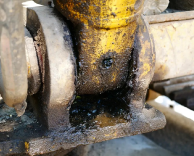Sub-Optimal Filter Performance | Common Causes and Solutions
Introduction
The filters are essential for the working of any machinery and industrial machines. Generally, replacing filters provides the best performance. This indicates that several problems can arise that make a filter unable to function properly, even when it has been changed to specification. In this article, we will examine the common problem areas that tend to cause filters to not perform their best and provide effective methods in fixing the issues found.
Importance of Proper Filter Selection and Installation
Choosing and installing the right filter is a great benefit. Note that selecting the right filter for the job based on its specs is only half of the battle; correct installation is the second half. Even a properly sized filter can deliver unsatisfactory results if installation problems or other factors compromise its effectiveness. The main factors related to the structural featuresRelated to filter media, integrity of seals, and the state of the bypass valve, are the main factors that have a great influence on the comprehensive performance of your filter system.
Common Reasons for Sub-Optimal Filter Performance
Even with proper filter selection and installation, the following key issues could degrade filter performance:
1) Collapsed Center Tube
For structural integrity and media stability during operation, the
filter is supported by a center tube. If the center tube fails,
the media cannot perform its filtration function. The result can
be increased loss pressure, restriction of flow, or total media
failure.
Solution: Make sure the center tube of the
filter is high-end, durable, and installed properly. If the filter
has collapsed at the center tube, you may need to replace it or
use a new filter model that does not collapse.
2) Inconsistent Media Quality
Media that capture contaminants from a liquid or gas or other
substances is called filter media. This means that if the
quality of the media is inconsistent, the filter might not trap
the particles as efficiently. This may lead to lower filter
efficiency or earlier clogging.
Solution: Carry out
frequent assessments of the media quality and choose filters from
reputable brands with strict quality control standards. And during
maintenance, use what you see of degradation or inconsistency as a
check of what you see in the media.
3) Incorrect Order of an Open or Broken Filter
Eventually, the filter media can go somewhat 'fatigued', resulting
in actual tears, ruptures, or even bursts. Excessive pressure,
incorrect handling, and the accumulation of contamination that
reduces the strength of the material can cause this. When the
filter media breaks, it will not filter out the contaminants
anymore and will allow the unfiltered fluid to go around the
filter.
Solution: Always check the media for signs of
damage visual e.g., punctures/tears or bulging. If wear is found,
change the filter and set the operating conditions within the
limits specified.
4) Leak at Joint in Filter Media
The media are sometimes stitched together at seams to provide a
continuous filtration layer in many filters. In the event that
media may not be bonded along these seams, during operation, the
seams can open, which allows contaminants to flow past the filter
media.
Solution: Periodically inspect filter media
seams for failure. Reinforcing seams to prevent bypass and
checking adhesives for high-temperature and chemical resistance.
5) Bypass due to adhesive failure
In some filter elements, the adhesive used to hold the filter
media together can deteriorate over time from heat, pressure, or
chemical exposure. This causes the media to break down, resulting
in a loss of filtering ability.
Resolutions: You need
to use quality, stable adhesives while applying the filter media
together. Look to invest in welded seam filters or other types
that have reduced the risk of adhesive failure.
6) Ruined Gasket or O-Ring Seal
Gasket/O-Ring Seal: The seal that fits between the filter and its
housing, the gasket or O-ring seal ensures the filter is held
tight and that no leakage takes place and that all fluids must
pass through the filter media. Fluid bypass due to a
damaged gasket or O-ring results in contaminants escaping
filtration.
Solution: Inspect the gaskets and O-rings
for cracks, cuts, and wear, and replace as needed. Where
applicable, replace them and select the right gasket material
according to the temperature, pressure and characteristics of the
fluid.
7) Bypass Valve Jammed
A bypass valve that will permit fluid to pass around the filter in
the event that the filter were to become blocked or malfunction.
The bypass valve allows fluid to bypass the filter, and if it
becomes stuck in the open or closed position, unfiltered fluid can
flow through the system or excessive pressure can build in the
system.
Solution: The bypass valve should be visibly
checked every now and then to ensure that it is working properly.
Where necessary, clean and lubricate the valve and replace if
signs of damage are evident.
8) Installation Mistakes (Flow Direction Incorrect)
In order for filters to work efficiently, they have to be
installed in the right flow direction. If a filter doesn't fit
properly, fluid can bypass the filter media or flow in a direction
not designed to handle.
Solution: Filters
should always be installed in accordance with the manufacturer´s
instructions( e. g. correct flow direction). Flow Direction Filter
Markings can help avoid installation errors
9) Bypass Valve Leakage
In some situations, a leak develops in the bypass valve, allowing
unfiltered fluid to enter the system. Wear, corrosion or faulty
design can cause this.
Solution: During periodic
checks, determine if the bypass valve is leaking. In case of a
leak, inspect the valve to see if there is damage and replace
it if needed.
10) The filter and seal are not aligned
In such scenarios, leakage and inefficient filtration can be
caused by a misalignment of the filter and the surface sealing it.
And even a slight deviation can drastically reduce the
efficiency of the filtration system.
Solution: Align
it correctly during installation. Ensure the filter and surface
mating points are clean and there are no foreign objects that may
lead to misalignment.
Best practice to avoid performance problems with Filters
- Check filters for signs of wear and/or damage regularly.
- Install it correctly in terms of flow direction and seal points
- Always get genuine filters from trusted manufacturers using good quality materials.
- Adhere to the manufacturer's specifications for environmental conditions and intervals for replacement.
- Do not allow the filtration system to be contaminated with chemicals that can harm the filter.
Conclusion
There are a variety of problems that can lead to sub-optimal filter performance, even in a post-filter replacement situation. The key to preventing downtime and keeping your systems running smoothly is to pinpoint the source of the problem and resolve it. A clean filter will remain effective for many years, provided that it is regularly monitored and practices are adhered to.
Get your
filter checked
today. Call +91 7030901266
We at Minimac Systems Pvt Ltd. provide services of Total
Lubrication Management and Lubrication Consulting that help you
optimize your Lubrication needs. Minimac stands for Minimum
Machinery Maintenance.
Learn more about our services and industry insights by visiting our official LinkedIn page: Minimac Systems





